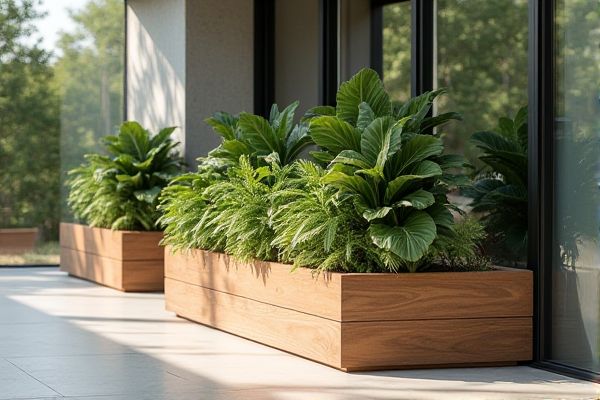
Modular planters offer flexibility and easy customization for your gardening needs, allowing you to rearrange or expand your green space effortlessly, while fixed planters provide a durable, stable structure ideal for permanent garden setups. Discover which option suits your lifestyle and gardening goals by reading the rest of the article.
Table of Comparison
| Feature | Modular Planter | Fixed Planter |
|---|---|---|
| Design Flexibility | Highly customizable; can be expanded or reconfigured | Permanent design; limited or no changes after installation |
| Installation | Easy and quick, often tool-free assembly | Complex installation; typically requires foundations or permanent fixtures |
| Cost | Generally higher initial cost due to modular components | Usually lower upfront cost but less adaptable |
| Maintenance | Simple maintenance; individual modules can be replaced | Maintenance is more challenging; entire planter may need repair |
| Mobility | Portable; can be relocated easily | Fixed in one location; not portable |
| Customization | Supports a variety of sizes, shapes, and materials | Limited to original design specifications |
| Durability | Dependent on modular materials; may have joints that weaken over time | Typically more durable due to solid, integrated construction |
Introduction to Modular and Fixed Planters
Modular planters offer customizable configurations by connecting multiple individual units, allowing flexibility in design and scalability for various spaces. Fixed planters feature a permanent, single-structure design that provides stability and a streamlined appearance, ideal for consistent landscape layouts. Both planter types serve distinct purposes in urban gardening and interior design, balancing adaptability and fixed aesthetics.
Design Flexibility and Customization
Modular planters offer unparalleled design flexibility, allowing you to easily rearrange and expand your garden layout to fit changing spaces or styles. Fixed planters provide a stable, permanent structure but limit customization options once installed. Choosing modular systems enhances personalization and adaptability, making them ideal for dynamic environments.
Installation and Setup
Modular planters offer flexible installation and easy scalability, allowing users to customize configurations without extensive tools or structural changes. Fixed planters require a more permanent setup, often involving heavy materials and specific placement that limits rearrangement. Both types may demand proper drainage and surface preparation, but modular systems simplify maintenance and relocation compared to fixed installations.
Space Efficiency and Adaptability
Modular planters offer superior space efficiency and adaptability by allowing you to customize the size and shape to fit any area, maximizing available space in both small balconies and large gardens. Their interlocking design enables easy expansion or reconfiguration, adapting to changing plant needs or seasonal rotations without the constraints of fixed planter dimensions. Fixed planters, while often more stable, limit flexibility and can underutilize space due to their permanent size and shape.
Maintenance Requirements
Modular planters require less maintenance due to their lightweight and detachable components, allowing easy cleaning and replacement of damaged parts without disturbing surrounding plants. Fixed planters are more durable but often demand more intensive upkeep, as their permanent installation can complicate soil replenishment and pest control. Selecting a modular planter can reduce long-term maintenance efforts, especially in commercial or high-traffic environments.
Durability and Lifespan
Modular planters offer enhanced durability due to their flexible construction, allowing individual components to be replaced or upgraded without discarding the entire unit, which extends their lifespan significantly. Fixed planters, often made from a single solid piece, may suffer from wear and damage that cannot be easily repaired, leading to a shorter overall lifespan. Choosing a modular planter can optimize longevity and maintenance efficiency for your gardening needs.
Cost Comparison
Modular planters typically offer lower upfront costs due to their versatility and ease of assembly, allowing gardeners to expand or reconfigure without purchasing new units. Fixed planters often involve higher initial investment because of their permanent materials and construction but may provide greater durability and long-term value. Evaluating total cost of ownership, including maintenance and replacement expenses, highlights modular planters as budget-friendly options for flexible gardening solutions.
Environmental Impact
Modular planters offer a sustainable advantage by allowing easy replacement and reconfiguration, reducing waste and the need for new materials compared to fixed planters which often require full replacement when damaged or outdated. The ability to reuse individual modules supports longevity and lowers resource consumption, contributing to reduced carbon footprints in urban landscaping projects. Fixed planters, while sturdy, generate more landfill waste and typically involve higher environmental costs in manufacturing and disposal processes.
Ideal Applications and Use Cases
Modular planters are ideal for dynamic urban spaces, rooftop gardens, and commercial environments where flexibility and scalability are essential. Fixed planters suit permanent landscaping projects such as parks, residential gardens, and street-side installations requiring stability and durable integration with the surroundings. Both types support diverse plant species, but modular designs excel in seasonal changes and customizable layouts.
Conclusion: Choosing the Best Planter Type
Selecting the best planter type depends on space flexibility, customization needs, and plant variety. Modular planters offer versatility with easy rearrangement and expansion options, ideal for dynamic gardening environments or limited spaces. Fixed planters provide stability and durability, making them suitable for permanent installations and larger plants requiring consistent support.
 homyna.com
homyna.com